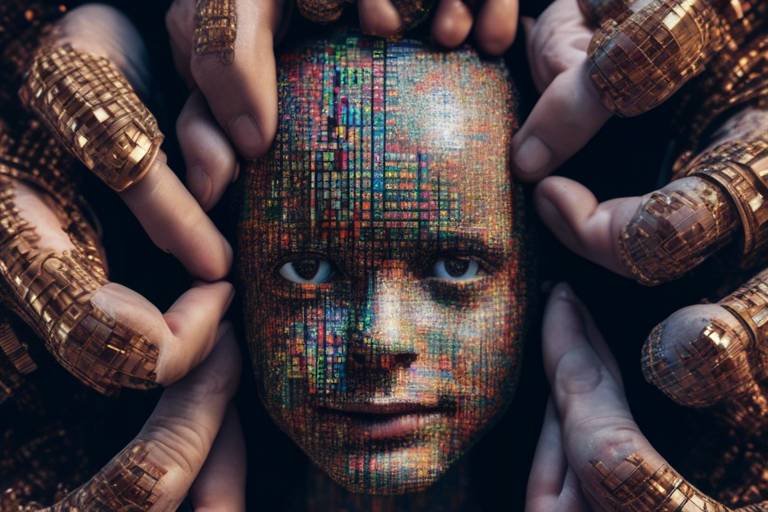The Tipping Point: Ethics and AI in Balance
As we stand on the brink of a technological revolution, the intersection of ethics and artificial intelligence (AI) has never been more critical. The rapid advancement of AI technologies presents not only remarkable opportunities but also profound challenges that necessitate a deep dive into ethical considerations. Imagine a world where machines make decisions that could affect our lives, our health, and even our freedoms. It’s a thrilling yet daunting thought, isn't it? The stakes are high, and the conversations surrounding AI ethics are becoming increasingly urgent.
At the heart of this discourse is the question of responsibility. Who is accountable when an AI system makes a mistake? Is it the developers, the users, or the very algorithms that operate in the shadows? These are not just technical questions; they are ethical dilemmas that demand our attention. As we navigate this complex landscape, we must consider how to balance innovation with responsibility, ensuring that the tools we create enhance human life rather than diminish it.
Moreover, the ethical frameworks that guide AI development are essential to understanding how we can responsibly harness this technology. Various ethical theories, such as utilitarianism, deontology, and virtue ethics, provide a foundation for developing AI systems that prioritize human welfare and societal good. For instance, a utilitarian approach might focus on maximizing overall happiness when designing AI applications, while a deontological perspective could emphasize the importance of adhering to ethical principles regardless of outcomes. By integrating these frameworks into the AI development process, we can create systems that are not only innovative but also aligned with our moral values.
But what does it mean to have an ethical AI? It’s about more than just compliance with laws or regulations; it’s about fostering a culture of transparency and trust. As we delve deeper into this article, we will explore the critical role of transparency in AI systems, the pressing issues of bias and fairness, and the ethical implications of data privacy. Each of these elements plays a significant role in shaping the future of AI and its impact on society.
As we embark on this journey together, let’s keep in mind that the conversation around AI ethics is not just for experts in the field. It’s for everyone. After all, we are all stakeholders in this evolving narrative, and understanding these complexities will empower us to engage with AI technologies more thoughtfully and responsibly.
Understanding the ethical frameworks that guide AI development is essential. This section discusses various ethical theories and principles that inform responsible AI practices and decision-making processes.
Transparency in AI systems is crucial for building trust. This section examines the importance of clear communication regarding AI operations and decision-making processes to ensure accountability and public confidence.
Addressing bias in AI algorithms is vital for fairness. This section delves into the sources of bias, its implications, and strategies to mitigate its impact on marginalized communities.
With AI's reliance on data, privacy becomes a significant concern. This section discusses the importance of protecting personal information and the ethical implications of data collection and usage.
AI's role in decision-making processes raises ethical questions. This section explores the implications of automated decisions in various sectors, including healthcare, finance, and law enforcement.
The rapid advancement of AI technologies presents regulatory challenges. This section analyzes current regulations and the need for updated policies to address ethical concerns and ensure responsible AI deployment.
Public perception of AI influences its acceptance and use. This section examines factors that shape trust in AI technologies and the importance of fostering a positive relationship between society and AI.
Looking ahead, the future of ethical AI is pivotal. This section discusses emerging trends, potential challenges, and the role of stakeholders in shaping a responsible and ethical AI landscape.
- What is AI ethics? AI ethics refers to the moral principles guiding the development and deployment of artificial intelligence technologies, ensuring they benefit society and do not cause harm.
- Why is transparency important in AI? Transparency builds trust and accountability, allowing users to understand how AI systems operate and make decisions, thus fostering public confidence.
- How can we address bias in AI? By implementing diverse datasets, regular audits, and inclusive practices during the development process, we can mitigate bias and promote fairness in AI systems.
- What are the privacy concerns related to AI? AI systems often rely on vast amounts of personal data, raising ethical concerns about consent, data security, and the potential for misuse of information.
- What is the future of ethical AI? The future of ethical AI involves ongoing dialogue among stakeholders, regulatory updates, and a commitment to prioritizing human welfare in AI development.

The Ethical Framework for AI
Understanding the ethical frameworks that guide the development of artificial intelligence (AI) is not just a technical necessity; it's a moral imperative. As we hurtle into a future increasingly dominated by AI technologies, the question arises: what principles should govern their design and deployment? Just like a compass guiding a ship through uncharted waters, ethical frameworks provide direction to ensure that AI serves humanity positively and equitably.
At the heart of these frameworks are several key ethical theories that inform responsible AI practices. Among them, **utilitarianism** stands out, advocating for actions that maximize overall happiness. In the context of AI, this means creating systems that benefit the greatest number of people. However, the challenge lies in measuring happiness and determining whose happiness counts. This is where the **deontological approach** comes into play, emphasizing duty and adherence to rules. For instance, AI systems should respect user privacy and data rights, reflecting a commitment to ethical principles rather than just outcomes.
Moreover, the **virtue ethics** perspective encourages developers to cultivate moral character and integrity in their AI systems. This approach suggests that the creators of AI should embody ethical virtues—like fairness, transparency, and accountability—ensuring these values are embedded in the technology itself. This is crucial because AI systems are not just tools; they reflect the values of their creators, and if those values are flawed, the technology will likely perpetuate those flaws.
To illustrate these concepts, consider a table that summarizes the main ethical theories relevant to AI:
| Ethical Theory | Description | AI Application |
|---|---|---|
| Utilitarianism | Maximizing overall happiness | Designing AI for public benefit |
| Deontological Ethics | Duty-based ethics, following rules | Respecting user privacy and rights |
| Virtue Ethics | Emphasizing moral character | Embedding ethical values in technology |
In addition to these theories, the **principles of accountability and fairness** are critical. Developers must ensure that AI systems are not only effective but also just. This requires continuous reflection on how AI decisions impact various stakeholders. For example, if an AI system is used in hiring processes, it should be evaluated for potential biases that could disadvantage certain groups. This leads to the necessity of incorporating a diverse range of perspectives during the development phase, ensuring that the technology is inclusive and equitable.
Furthermore, the importance of **stakeholder engagement** cannot be overstated. Engaging with ethicists, sociologists, and the communities affected by AI systems is essential for creating a robust ethical framework. This collaborative approach helps identify potential ethical dilemmas before they arise, allowing for proactive measures to be taken.
Ultimately, the ethical framework for AI is not a one-size-fits-all solution. It requires ongoing dialogue and adaptation as technology evolves. The responsibility lies not only with developers but also with policymakers, businesses, and society at large to cultivate a culture of ethical awareness in AI development. Only then can we ensure that AI technologies are harnessed for the greater good, balancing innovation with responsibility.

The Role of Transparency
In today's world, where technology evolves at lightning speed, the role of transparency in artificial intelligence (AI) cannot be overstated. Imagine driving a car with tinted windows; you might feel safe, but you can't see the road ahead. Similarly, when AI systems operate without transparency, they create a fog of uncertainty that can lead to mistrust and skepticism. Transparency allows stakeholders—be it developers, users, or the general public—to understand how AI systems make decisions, which is crucial for fostering trust and accountability.
Transparency in AI encompasses several dimensions, including the clarity of algorithms, the data used, and the rationale behind decisions made by AI systems. When companies openly share information about their AI processes, it demystifies the technology and encourages a culture of responsibility. For instance, if a healthcare AI tool recommends a treatment, knowing how it arrived at that conclusion can help doctors and patients make informed decisions. This is especially important in sensitive areas like healthcare, finance, and law enforcement, where the stakes are incredibly high.
Moreover, transparency can act as a safeguard against bias and discrimination. When AI algorithms are open to scrutiny, it becomes easier to identify potential biases that could adversely affect marginalized communities. By making the workings of AI systems accessible, organizations can foster a collaborative effort to address ethical dilemmas. This brings us to the notion of accountability; if an AI system makes a mistake, who is responsible? Transparency helps clarify these issues, allowing for a more straightforward attribution of responsibility.
To illustrate the importance of transparency, consider the following table that outlines key aspects of AI transparency:
| Aspect | Description |
|---|---|
| Algorithmic Clarity | Understanding how algorithms function and make decisions. |
| Data Disclosure | Sharing information about the datasets used for training AI models. |
| Decision Rationale | Explaining the reasoning behind AI-generated outcomes. |
| Accountability Mechanisms | Establishing who is accountable for AI decisions and actions. |
One might wonder, how can organizations improve transparency in their AI systems? Here are a few strategies:
- Open Communication: Engage with stakeholders through forums, reports, and social media to explain AI functionalities.
- Documentation: Maintain comprehensive documentation that outlines how AI models are built, trained, and tested.
- Third-Party Audits: Invite independent reviews to assess AI systems for bias and fairness.
In conclusion, the role of transparency in AI is not just a nice-to-have; it's a necessity. As AI continues to permeate various aspects of our lives, ensuring that these systems are transparent will be crucial for building trust and accountability. After all, in a world increasingly governed by algorithms, wouldn't you want to know what's behind the curtain?

Bias and Fairness in AI
In the rapidly evolving world of artificial intelligence, bias has emerged as a critical issue that cannot be ignored. Imagine a world where decisions about your life—like whether you get a loan, a job, or even medical treatment—are made by algorithms that reflect historical prejudices. This is not just a dystopian scenario; it is a reality that many marginalized communities face today. Bias in AI systems often stems from the data used to train these algorithms. If the data reflects existing societal inequalities, the AI will likely perpetuate those biases, leading to unfair outcomes.
One of the most troubling aspects of AI bias is its invisibility. Many users trust AI systems to make objective decisions, yet these systems can be influenced by the very biases they were designed to eliminate. For instance, facial recognition technology has been shown to misidentify individuals from minority groups at a significantly higher rate than their white counterparts. This discrepancy raises serious ethical questions about the fairness of these technologies. Are we comfortable allowing machines to make decisions that could fundamentally alter lives based on flawed data?
To tackle bias effectively, it is essential to first understand its sources. Bias can creep into AI systems through various channels:
- Data Selection: If the training dataset is not representative of the entire population, the AI model will inherit those biases.
- Data Labeling: Human annotators may introduce their own biases when labeling data, which can skew the AI's learning process.
- Algorithm Design: The way algorithms are structured can also lead to biased outcomes if not carefully monitored.
Addressing these biases requires a multi-faceted approach. Here are some strategies that can help mitigate bias in AI:
- Diverse Data Sets: Ensuring that training data is inclusive and representative of all demographics can help create a more balanced AI.
- Regular Audits: Conducting audits of AI systems to identify and rectify any biases can enhance fairness.
- Inclusive Design Teams: Having diverse teams involved in the development of AI technologies can lead to more equitable outcomes.
Furthermore, transparency is crucial. Developers must be open about how AI systems are trained and the data they utilize. This openness not only fosters accountability but also allows for public scrutiny, which can help identify biases that may have gone unnoticed. In this age of information, trust is paramount, and transparency is the bedrock upon which that trust is built.
In summary, as we continue to integrate AI into various aspects of society, it is vital to remain vigilant about the potential for bias. By acknowledging the challenges and actively working towards fairness, we can create AI systems that serve everyone equitably. The future of AI should not just be about efficiency and speed but also about justice and equality.
- What is AI bias? AI bias occurs when algorithms produce results that are systematically prejudiced due to erroneous assumptions in the machine learning process.
- How does bias affect AI systems? Bias can lead to unfair treatment of individuals, especially those from marginalized communities, impacting decisions in areas like hiring, law enforcement, and healthcare.
- What can be done to minimize bias in AI? Strategies include using diverse datasets, conducting regular audits, and involving inclusive design teams to ensure fair outcomes.

Data Privacy Concerns
As we dive deeper into the world of artificial intelligence, one of the most pressing issues we encounter is data privacy. With AI systems heavily reliant on vast amounts of data to learn and make decisions, the question arises: how much of our personal information is at stake? Imagine walking into a store where every interaction is monitored, analyzed, and stored. This is the reality many of us face online, where our data is collected not just for convenience, but often without our explicit consent.
The ethical implications of data collection are profound. On one hand, data is the lifeblood of AI; it fuels algorithms that can improve healthcare, enhance customer experiences, and streamline processes across various industries. On the other hand, the potential for misuse of this data is alarming. From identity theft to unauthorized surveillance, the risks are numerous and can have devastating effects on individuals and society at large.
Moreover, the lack of transparency surrounding data usage often leaves individuals in the dark. Many people are unaware of how their data is being collected, processed, and shared. This opacity breeds mistrust, making it essential for companies and developers to adopt clear communication practices. To foster trust, organizations must openly disclose their data practices, ensuring users are informed about what data is collected and how it is used.
To illustrate the gravity of data privacy concerns, let's look at a few statistics:
| Concern | Percentage of Users Affected |
|---|---|
| Identity Theft | 33% |
| Data Breaches | 29% |
| Unauthorized Data Sharing | 45% |
These numbers highlight the urgency of addressing data privacy concerns in the age of AI. The consequences of neglecting privacy can lead to significant legal repercussions for companies, not to mention a loss of consumer trust. Therefore, businesses must prioritize robust data protection strategies, such as implementing encryption, conducting regular audits, and ensuring compliance with data protection regulations like GDPR.
Furthermore, the ethical use of AI must extend beyond mere compliance with laws. It involves a moral obligation to protect user data and respect individual privacy. Companies should adopt a privacy-first approach, where the protection of personal information is embedded into every aspect of their operations. This proactive stance not only safeguards users but also enhances the company's reputation and fosters long-term relationships with customers.
In closing, as we navigate the complexities of AI and data privacy, it is crucial to strike a balance between innovation and ethical responsibility. By prioritizing data privacy, we can harness the full potential of AI while ensuring that individuals' rights are respected and protected. After all, in a world where data is currency, safeguarding it should be our highest priority.
- What is data privacy? Data privacy refers to the proper handling, processing, storage, and use of personal information.
- Why is data privacy important in AI? Data privacy is essential in AI to protect individuals from misuse of their personal information and to build trust between users and AI systems.
- How can companies ensure data privacy? Companies can ensure data privacy by implementing strong security measures, being transparent about data usage, and complying with relevant regulations.
- What are the consequences of data breaches? Consequences of data breaches can include financial loss, legal penalties, and damage to a company's reputation.

AI in Decision-Making
Artificial Intelligence (AI) is not just a buzzword; it's a transformative force reshaping how decisions are made across various sectors. From healthcare to finance, AI systems are increasingly taking on roles that were once the exclusive domain of humans. But here's where it gets tricky: when machines start making decisions, ethical questions pop up like weeds in a garden. Are we ready to trust algorithms with our lives, our money, and even our freedom? This brings us to the heart of the matter—**the implications of automated decisions**.
Let’s consider healthcare, for instance. Imagine a scenario where an AI system analyzes a patient's medical history and symptoms to recommend treatment options. While this can lead to faster and potentially more accurate diagnoses, we must ask ourselves: what happens if the AI makes a mistake? Unlike a human doctor who can explain their reasoning, an AI might provide a recommendation based on complex algorithms that are difficult to interpret. This lack of transparency can be alarming for patients who want to understand the rationale behind their treatment.
Moreover, the stakes are incredibly high when it comes to sectors like finance. AI-driven trading systems can execute trades in milliseconds, capitalizing on market fluctuations that a human trader could never catch. While this can maximize profits, it also poses risks—what if an algorithm misinterprets data and triggers a market crash? The 2010 Flash Crash serves as a stark reminder of how quickly things can spiral out of control when decisions are left to machines.
In law enforcement, AI tools are being utilized to predict criminal activity and allocate police resources. While this can enhance public safety, it raises **serious ethical concerns**. For instance, if an algorithm is trained on biased data, it may disproportionately target marginalized communities, perpetuating existing inequalities. This is where the conversation about **bias and fairness** in AI becomes crucial. We need to ensure that these systems are not only effective but also just and equitable.
To navigate these complex issues, we must establish a framework for ethical AI decision-making. Here are some essential principles that should guide the development and deployment of AI in decision-making:
- Accountability: Who is responsible when an AI makes a mistake? Clear lines of accountability must be established.
- Transparency: AI systems should operate in a way that their decision-making processes can be understood by humans.
- Fairness: Efforts must be made to eliminate bias in AI algorithms to ensure equitable treatment for all individuals.
- Privacy: Respecting individuals' data privacy is paramount, especially when sensitive information is involved.
As we continue to integrate AI into our decision-making processes, it's essential to maintain a **human touch**. After all, technology should serve humanity, not the other way around. We must ensure that while AI can enhance efficiency and accuracy, it does not replace the ethical considerations that come with human judgment. The future of AI in decision-making is bright, but it requires a commitment to ethical principles that prioritize human welfare above all else.
Q: What are the main risks associated with AI in decision-making?
A: The primary risks include lack of transparency, potential biases in algorithms, accountability issues, and privacy concerns.
Q: How can we ensure AI systems are fair?
A: Regular audits, diverse training data, and inclusive development processes can help mitigate bias and ensure fairness.
Q: Is AI capable of making ethical decisions?
A: While AI can analyze data and suggest options, it lacks the human capacity for empathy and moral reasoning, making human oversight essential.
Q: What role does transparency play in AI decision-making?
A: Transparency builds trust; when users understand how AI systems make decisions, they are more likely to accept and rely on them.

Regulatory Challenges
As we stand on the precipice of a technological revolution, the surrounding artificial intelligence (AI) are becoming increasingly apparent. The rapid pace at which AI technologies are evolving often outstrips the ability of existing laws and regulations to keep up. This creates a precarious situation where innovative solutions can flourish, but without proper oversight, they may also lead to unintended consequences. So, what are the key challenges that regulators face in this brave new world?
One of the most pressing issues is the lack of a unified regulatory framework. Different countries and regions are approaching AI regulation in vastly different ways, leading to a patchwork of laws that can be confusing for developers and businesses alike. For instance, the European Union is pushing forward with its AI Act, which aims to impose strict regulations on high-risk AI applications, while the United States has taken a more laissez-faire approach, focusing on self-regulation and industry standards. This divergence can stifle innovation as companies grapple with compliance across multiple jurisdictions.
Another significant challenge is the dynamic nature of AI technology. AI systems evolve rapidly, often learning and adapting in real-time. This adaptability makes it difficult for regulators to establish rules that remain relevant over time. How do you create a set of regulations that can effectively govern a technology that is constantly changing? This is akin to trying to catch smoke with your bare hands; the moment you think you have a grasp on it, it slips away. As a result, many regulatory bodies are finding themselves in a reactive position, responding to issues as they arise rather than proactively preventing them.
Furthermore, there are ethical considerations that complicate regulatory efforts. The question of who is responsible when AI systems cause harm—be it through bias, privacy violations, or erroneous decisions—remains largely unanswered. Should the developers, users, or the AI itself be held accountable? This ambiguity creates a chilling effect on innovation, as companies may hesitate to invest in AI technologies due to fears of liability. For instance, if an AI-driven healthcare system misdiagnoses a patient, who bears the responsibility? Such questions underscore the need for clear guidelines that address accountability and liability in AI applications.
To tackle these challenges, a collaborative approach is essential. Regulators, technologists, and ethicists must come together to create a framework that balances innovation with responsibility. This could involve the establishment of multi-stakeholder committees that include voices from various sectors, ensuring that diverse perspectives are considered in the regulatory process. Additionally, ongoing dialogue between regulators and the tech industry is crucial to keep pace with advancements and to understand the implications of emerging technologies.
In conclusion, the regulatory landscape for AI is fraught with challenges, but it is also ripe with opportunities. By fostering collaboration and embracing a flexible regulatory approach, we can create an environment where AI can thrive while ensuring that ethical considerations are at the forefront. As we navigate these uncharted waters, it's essential to remember that the goal is not to stifle innovation but to guide it in a direction that benefits society as a whole.
- What are the main regulatory challenges for AI? The main challenges include the lack of a unified regulatory framework, the dynamic nature of AI technology, and ethical considerations surrounding accountability and liability.
- Why is a collaborative approach important? A collaborative approach ensures that diverse perspectives are considered, which can lead to more effective and comprehensive regulations.
- How can we ensure that AI innovation continues? By creating flexible regulations that adapt to technological advancements while prioritizing ethical considerations, we can foster an environment conducive to innovation.

Public Perception and Trust
Public perception of artificial intelligence (AI) plays a crucial role in shaping its acceptance and integration into our daily lives. Imagine AI as a new neighbor moving into your community; at first, you're curious but also a bit apprehensive. Will they be friendly? Will they respect your privacy? These questions mirror the thoughts swirling in the minds of many as they encounter AI technologies. Trust is a fundamental element in this equation, and without it, the potential of AI remains largely untapped.
One of the significant factors influencing public trust in AI is transparency. When people understand how AI systems operate and make decisions, they are more likely to feel comfortable with their use. For instance, consider a healthcare AI that assists doctors in diagnosing diseases. If patients know how the AI reaches its conclusions—such as analyzing medical history and symptoms—they are more likely to trust its recommendations. However, when AI operates like a "black box," with little insight into its decision-making processes, skepticism can arise. This lack of clarity can lead to fears about accountability and whether AI can be held responsible for its actions.
Moreover, the media plays a pivotal role in shaping public perception. Sensational headlines and dystopian narratives can create fear and misunderstanding around AI technologies. For example, when news outlets focus on AI failures or ethical breaches, it can lead to a general distrust of the technology. On the flip side, positive stories showcasing AI's benefits—like improving efficiency in businesses or enhancing personal safety—can help build confidence. Thus, a balanced representation of AI in the media is essential for fostering a more informed public dialogue.
Another important aspect is the involvement of diverse stakeholders in the development and deployment of AI systems. When people see that their voices are heard—especially those from marginalized communities—they are more likely to trust the technology. Engaging with the public through forums, surveys, and discussions can demystify AI and make it feel more accessible. It’s about creating a community around AI, where individuals feel they have a stake in its development and use.
Furthermore, education plays a vital role in shaping perceptions. By providing resources and training to help people understand AI, we can demystify the technology and reduce fear. Schools, universities, and community organizations can all contribute to this educational effort. When individuals are equipped with knowledge, they can better navigate the complexities of AI, leading to a more informed and trusting populace.
In conclusion, public perception and trust in AI are not static; they evolve based on transparency, media representation, stakeholder involvement, and education. As we continue to advance technologically, it’s essential to prioritize these aspects to foster a positive relationship between society and AI. After all, trust is the foundation upon which the future of AI will be built, and without it, we risk hindering the incredible potential that this technology holds.
- What is the importance of public perception in AI? Public perception influences how AI technologies are accepted and utilized in society. A positive perception can lead to wider adoption, while negative views can hinder progress.
- How can transparency improve trust in AI? Transparency allows users to understand how AI systems operate, which fosters trust and accountability, making people more comfortable with AI applications.
- What role does education play in shaping AI perceptions? Education equips individuals with the knowledge to understand AI, reducing fear and skepticism, and promoting informed discussions about its benefits and risks.

The Future of Ethical AI
The future of ethical AI is not just a distant dream; it's a pressing reality that we must confront today. As artificial intelligence continues to evolve at a breakneck pace, the question arises: how can we ensure that these technologies serve humanity in a responsible and equitable manner? The answer lies in a collective commitment to ethical principles that guide the development and deployment of AI systems. Imagine a world where AI not only enhances our daily lives but does so while respecting our values and rights. This vision is achievable, but it requires concerted effort from all stakeholders involved.
One of the key trends shaping the future of ethical AI is the increasing emphasis on collaboration. Tech companies, governments, and civil society must work together to create frameworks that prioritize ethical considerations. This collaboration can take many forms, such as public-private partnerships, where insights from various sectors come together to inform AI policies. For instance, when developing AI for healthcare, input from medical professionals, ethicists, and patients can lead to more balanced and fair outcomes. The more diverse the voices in the conversation, the better the solutions we can create.
Moreover, the role of education cannot be overstated. As AI becomes more integrated into our lives, understanding its implications becomes essential. Educational institutions should incorporate AI ethics into their curricula, preparing future leaders to navigate the complex landscape of AI technology. Imagine students graduating not only with technical skills but also with a robust understanding of the ethical dilemmas they may face. They will be better equipped to challenge biases, advocate for transparency, and prioritize user privacy. This shift in education will ultimately lead to a generation of professionals who are not only tech-savvy but also socially responsible.
In addition to collaboration and education, the importance of regulatory frameworks will continue to grow. As AI technologies advance, existing regulations may become outdated. Policymakers must remain agile, adapting laws to address new ethical challenges that arise. This could involve establishing regulatory bodies specifically focused on AI, ensuring that ethical guidelines are not only created but also enforced. A well-structured regulatory environment can help mitigate risks associated with AI, such as algorithmic bias and data privacy violations.
Furthermore, the future of ethical AI will likely see a rise in accountability measures. As AI systems take on more significant roles in decision-making, it’s crucial to establish mechanisms that hold developers and organizations accountable for their AI's actions. This could include audits of AI systems to ensure they operate fairly and transparently. Just as we expect accountability in other sectors, such as finance and healthcare, the same standards should apply to AI. By demanding accountability, we can foster a culture of responsibility that permeates the tech industry.
As we look ahead, we must also consider the role of public engagement. The public's perception of AI will shape its acceptance and integration into society. Engaging citizens in discussions about AI ethics can demystify the technology and build trust. Town hall meetings, online forums, and educational campaigns can empower individuals to voice their concerns and expectations regarding AI. When people feel heard, they are more likely to embrace AI innovations, knowing that their values are being respected.
In conclusion, the future of ethical AI is a landscape filled with potential, but it requires a proactive approach. By fostering collaboration, enhancing education, establishing regulatory frameworks, promoting accountability, and engaging the public, we can steer AI development in a direction that benefits everyone. The journey toward ethical AI is not without its challenges, but with determination and unity, we can create a future where technology and ethics coexist harmoniously.
- What is ethical AI? Ethical AI refers to the development and use of artificial intelligence technologies in a manner that respects human rights, promotes fairness, and prevents harm.
- Why is transparency important in AI? Transparency helps build trust and accountability in AI systems, allowing users to understand how decisions are made.
- How can bias in AI be addressed? Bias can be mitigated through diverse data sets, regular audits, and inclusive design principles that consider the needs of all communities.
- What role do regulations play in ethical AI? Regulations help ensure that AI technologies are developed and used responsibly, protecting individuals and society from potential harms.
- How can the public engage with AI ethics? Public engagement can occur through discussions, educational initiatives, and feedback mechanisms that allow citizens to express their views on AI technologies.
Frequently Asked Questions
- What is the significance of ethics in AI development?
Ethics in AI development is crucial because it helps guide the creation and implementation of technologies that are aligned with human values. As AI systems have the potential to impact lives significantly, ensuring that they are developed responsibly can prevent harm and promote fairness.
- How do transparency and accountability relate to AI?
Transparency in AI systems fosters trust between developers and users. When AI operations are clearly communicated, it allows people to understand how decisions are made, which is essential for accountability. This helps build public confidence in AI technologies.
- What are the main sources of bias in AI?
Bias in AI can stem from various sources, including biased training data, flawed algorithms, and the subjective choices made by developers. These biases can lead to unfair outcomes, particularly affecting marginalized communities, making it vital to address them proactively.
- Why is data privacy a concern in AI?
Data privacy is a significant concern in AI because these systems often rely on vast amounts of personal data. Protecting this information is essential to prevent misuse and to uphold individuals' rights, ensuring that data collection and usage are ethical and secure.
- How does AI impact decision-making in various sectors?
AI's role in decision-making can enhance efficiency and accuracy in sectors like healthcare, finance, and law enforcement. However, it raises ethical questions about accountability and the potential for automated decisions to overlook human nuances, which can lead to unintended consequences.
- What are the current regulatory challenges regarding AI?
The rapid pace of AI technology development presents significant regulatory challenges, including the need for updated policies that address ethical concerns. Current regulations may not adequately cover the complexities of AI, necessitating a reevaluation to ensure responsible deployment.
- How does public perception affect the acceptance of AI?
Public perception plays a pivotal role in the acceptance of AI technologies. Factors such as trust, understanding, and media portrayal can influence how society views AI, making it essential to foster a positive relationship through education and transparent practices.
- What does the future hold for ethical AI?
The future of ethical AI is promising yet challenging. Emerging trends will require collaboration among stakeholders to address potential ethical dilemmas and ensure that AI technologies are developed and implemented in ways that prioritize human well-being and societal benefit.



















